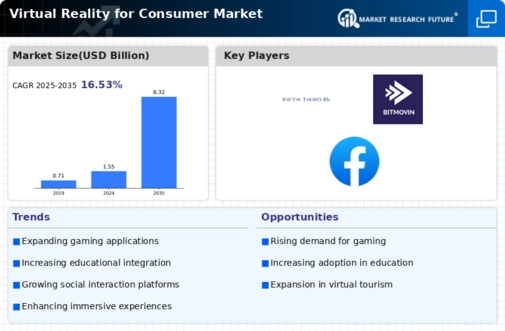Top Industry Leaders in the Virtual Reality Consumer Market

The Competitive Landscape of the Virtual Reality for Consumer Market
The virtual reality (VR) market for consumers, where pixels paint fantastical worlds. In this dynamic arena, established tech giants and nimble innovators clash, all vying for a bigger share of the VR landscape. From immersive gaming experiences to remote collaboration and artistic expression, VR is redefining entertainment, communication, and the very boundaries of reality. Let's dissect the key strategies and players shaping this captivating scene.
Key Player:
- Alibaba Group Holding Limited
- Nvidia Corporation com, Inc.
- Bitmovin
- Google LLC
- Leap Motion, Inc.
- nDreams, Ltd.
- Sony Corporation
- Microsoft Corporation
- Facebook, Inc.
- Binary VR Inc.
- Leap Motion, Inc.
Strategies Adopted by Market Leaders:
- Technological Differentiation: Companies compete fiercely on technological advancements, focusing on factors like improved field-of-view, higher resolution displays, reduced latency for smoother visuals, and innovative controller designs for intuitive interactions. Developing wireless options for untethered freedom, optimizing comfort for extended wear, and integrating haptic feedback for enhanced immersion are key differentiators.
- Expanding Content Ecosystems: Building a diverse and engaging content library is crucial for keeping users coming back for more. Companies invest in exclusive game titles, partner with established developers, and create platforms for user-generated content. Developing VR experiences beyond gaming with applications like fitness programs, educational tools, and virtual tourism expands the market and attracts new user segments.
- Addressing Accessibility and Affordability: Making VR more affordable and accessible to a wider audience is vital for market growth. Offering a range of price points, developing budget-friendly headsets, and exploring subscription models are key strategies. Simplifying setup processes, optimizing compatibility with existing hardware, and providing clear user education are crucial for widespread adoption.
- Building Partnerships and Collaborations: Fostering partnerships with game developers, content creators, hardware manufacturers, and technology providers accelerates innovation, shares expertise, and expands market reach. Collaborating on industry standards, developing interoperable platforms, and promoting the benefits of VR for entertainment, education, and collaboration contribute to market growth.
Factors for Market Share Analysis:
- Hardware Unit Sales: This straightforward metric reflects a company's penetration into the consumer market and reach.
- Content Library Size and Engagement: Analyzing the volume and diversity of VR experiences available on a platform reveals its potential to attract and retain users.
- Technology Advancements: Assessing a company's investment in R&D, patent portfolio, and cutting-edge VR technologies helps gauge its future competitive edge.
- User Satisfaction and Community Engagement: Analyzing consumer feedback and community activity reveals how effectively a company caters to user needs and builds brand loyalty.
New and Emerging Companies:
The influx of innovative startups is adding new brushstrokes to the VR canvas. Companies like Pimax (China), Varjo (Finland), and iQIYI (China) introduce novel solutions like ultra-wide field-of-view headsets for cinematic experiences, high-resolution displays for professional applications, and cloud-based VR platforms for accessibility and scalability. These advancements redefine the possibilities of VR and unlock niche markets for immersive entertainment, business applications, and cloud-based VR experiences.
Industry Developments:
HTC Corporation:
- October 24, 2023- Launched the Vive Focus 3 G, a standalone headset targeting enterprise applications with a focus on business use cases.
Pico Interactive (China):
- September 12, 2023- Partnered with Tencent to distribute VR content and expand market reach in China.
ByteDance (China):
- August 8, 2023- Integrated social features like virtual avatars and chatrooms into the Pico 4, boosting its appeal for social interaction and virtual communities.
